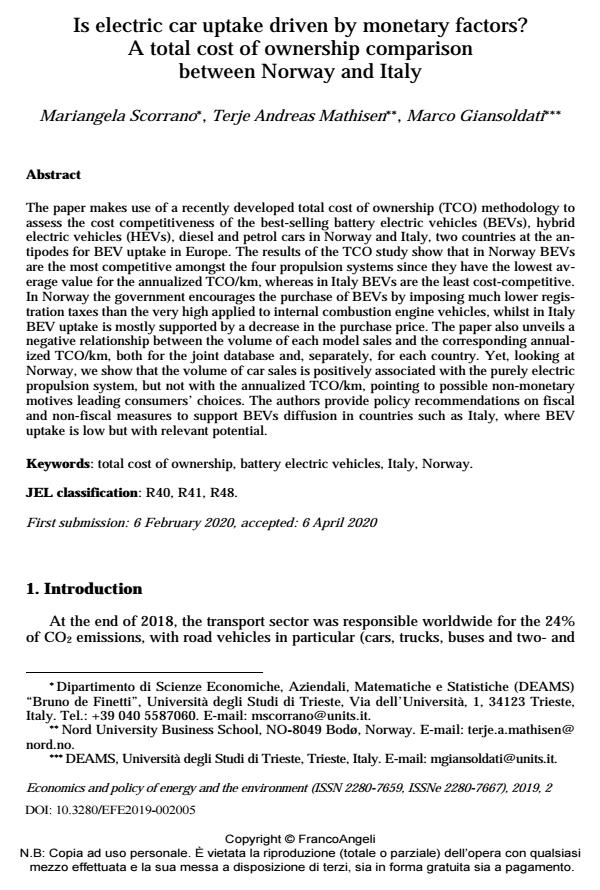Is electric car uptake driven by monetary factors? A total cost of ownership comparison between Norway and Italy
Titolo Rivista ECONOMICS AND POLICY OF ENERGY AND THE ENVIRONMENT
Autori/Curatori Mariangela Scorrano, Terje Andreas Mathisen, Marco Giansoldati
Anno di pubblicazione 2020 Fascicolo 2019/2
Lingua Inglese Numero pagine 34 P. 99-132 Dimensione file 350 KB
DOI 10.3280/EFE2019-002005
Il DOI è il codice a barre della proprietà intellettuale: per saperne di più
clicca qui
Qui sotto puoi vedere in anteprima la prima pagina di questo articolo.
Se questo articolo ti interessa, lo puoi acquistare (e scaricare in formato pdf) seguendo le facili indicazioni per acquistare il download credit. Acquista Download Credits per scaricare questo Articolo in formato PDF

FrancoAngeli è membro della Publishers International Linking Association, Inc (PILA)associazione indipendente e non profit per facilitare (attraverso i servizi tecnologici implementati da CrossRef.org) l’accesso degli studiosi ai contenuti digitali nelle pubblicazioni professionali e scientifiche
The paper makes use of a recently developed total cost of ownership (TCO) methodology to assess the cost competitiveness of the best-selling battery electric vehicles (BEVs), hybrid electric vehicles (HEVs), diesel and petrol cars in Norway and Italy, two countries at the antipodes for BEV uptake in Europe. The results of the TCO study show that in Norway BEVs are the most competitive amongst the four propulsion systems since they have the lowest average value for the annualized TCO/km, whereas in Italy BEVs are the least cost-competitive. In Norway the government encourages the purchase of BEVs by imposing much lower registration taxes than the very high applied to internal combustion engine vehicles, whilst in Italy BEV uptake is mostly supported by a decrease in the purchase price. The paper also unveils a negative relationship between the volume of each model sales and the corresponding annualized TCO/km, both for the joint database and, separately, for each country. Yet, looking at Norway, we show that the volume of car sales is positively associated with the purely electric propulsion system, but not with the annualized TCO/km, pointing to possible non-monetary motives leading consumers’ choices. The authors provide policy recommendations on fiscal and non-fiscal measures to support BEVs diffusion in countries such as Italy, where BEV uptake is low but with relevant potential.
Parole chiave:Total cost of ownership, battery electric vehicles, Italy, Norway.
Jel codes:R40, R41, R48.
- Drivers’ preferences for electric cars in Italy. Evidence from a country with limited but growing electric car uptake Romeo Danielis, Lucia Rotaris, Marco Giansoldati, Mariangela Scorrano, in Transportation Research Part A: Policy and Practice /2020 pp.79
DOI: 10.1016/j.tra.2020.04.004
Mariangela Scorrano, Terje Andreas Mathisen, Marco Giansoldati, Is electric car uptake driven by monetary factors? A total cost of ownership comparison between Norway and Italy in "ECONOMICS AND POLICY OF ENERGY AND THE ENVIRONMENT" 2/2019, pp 99-132, DOI: 10.3280/EFE2019-002005